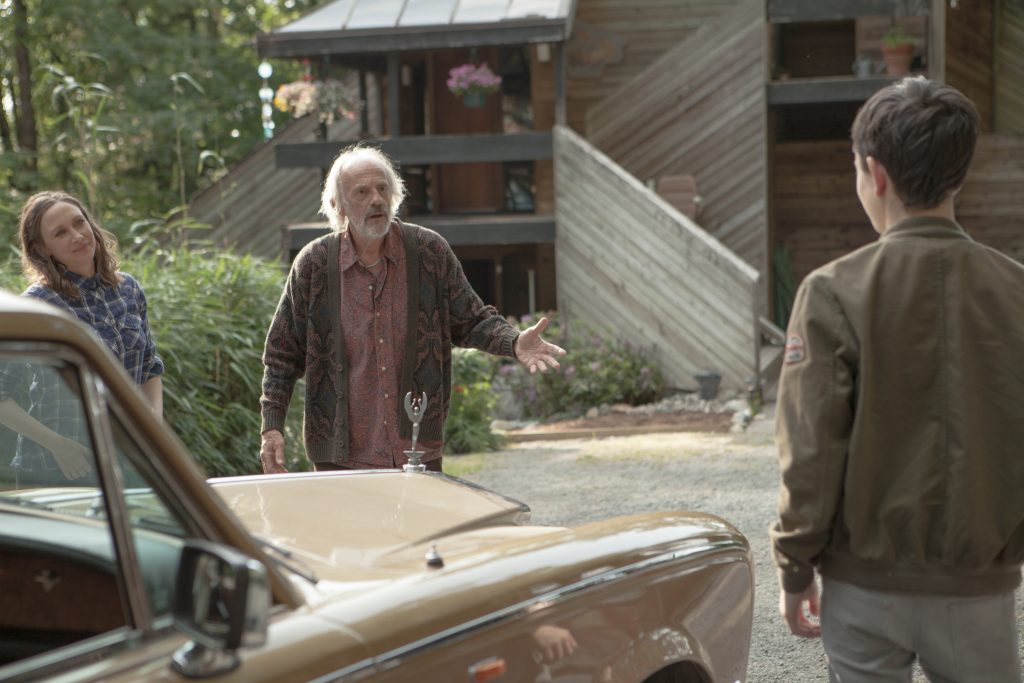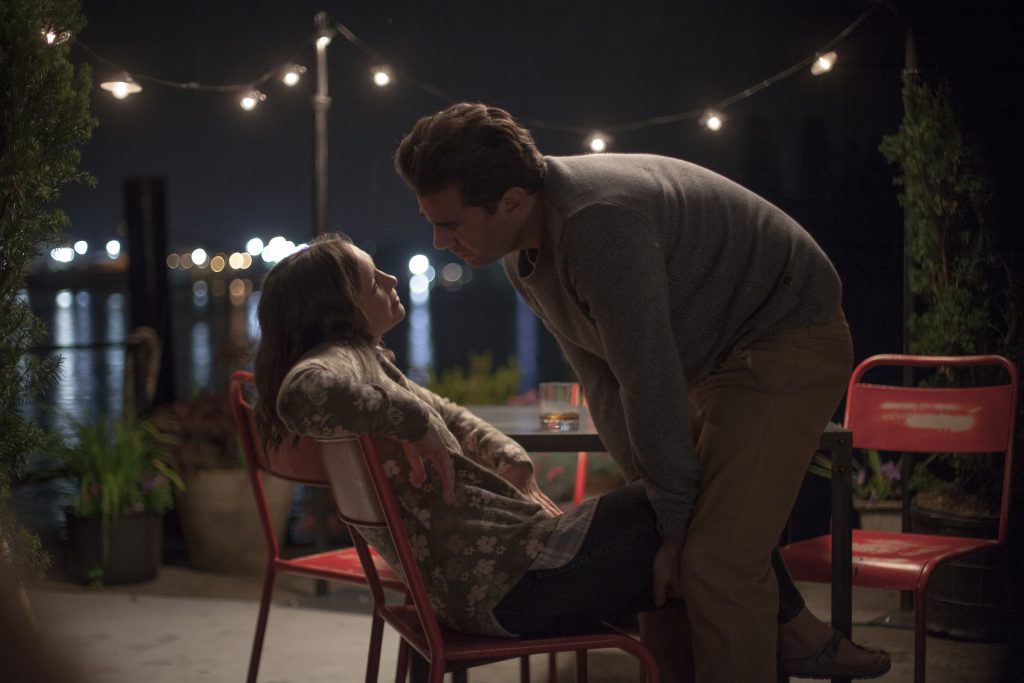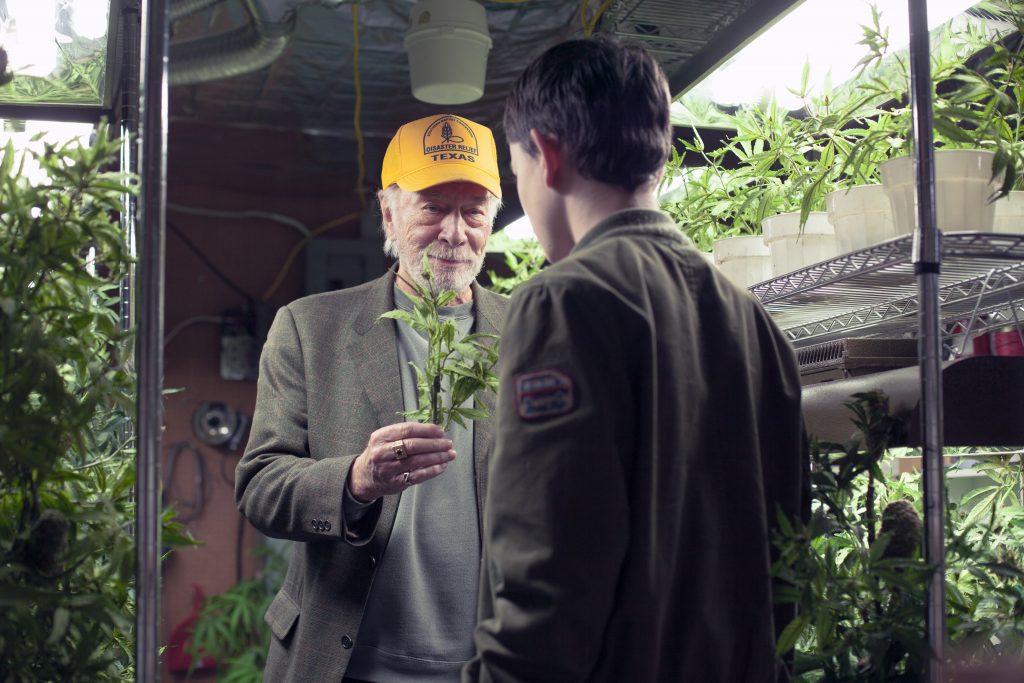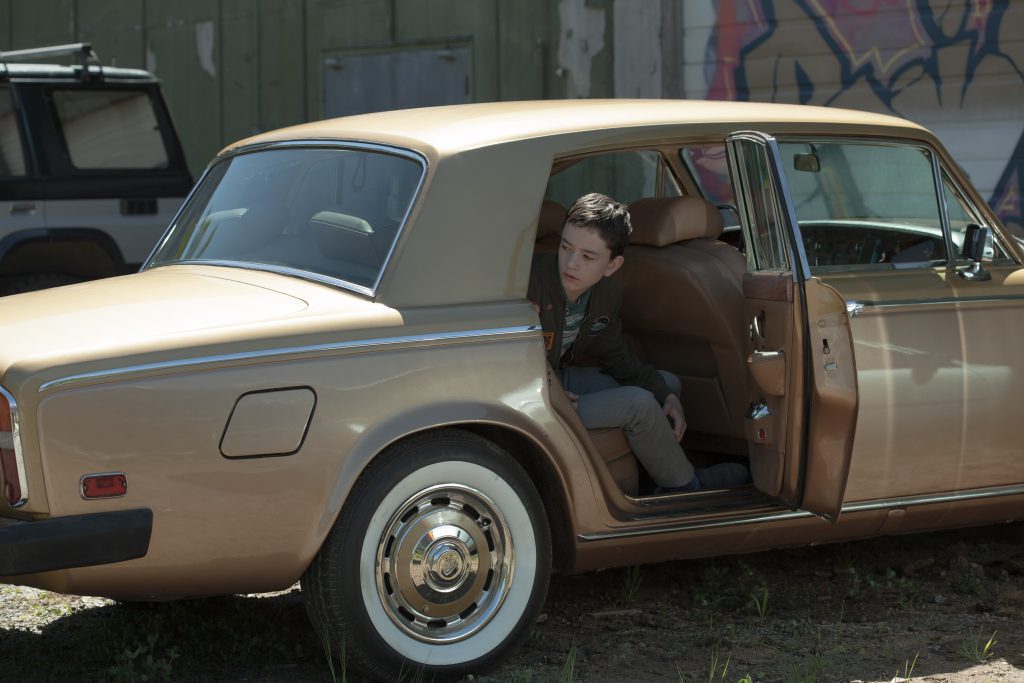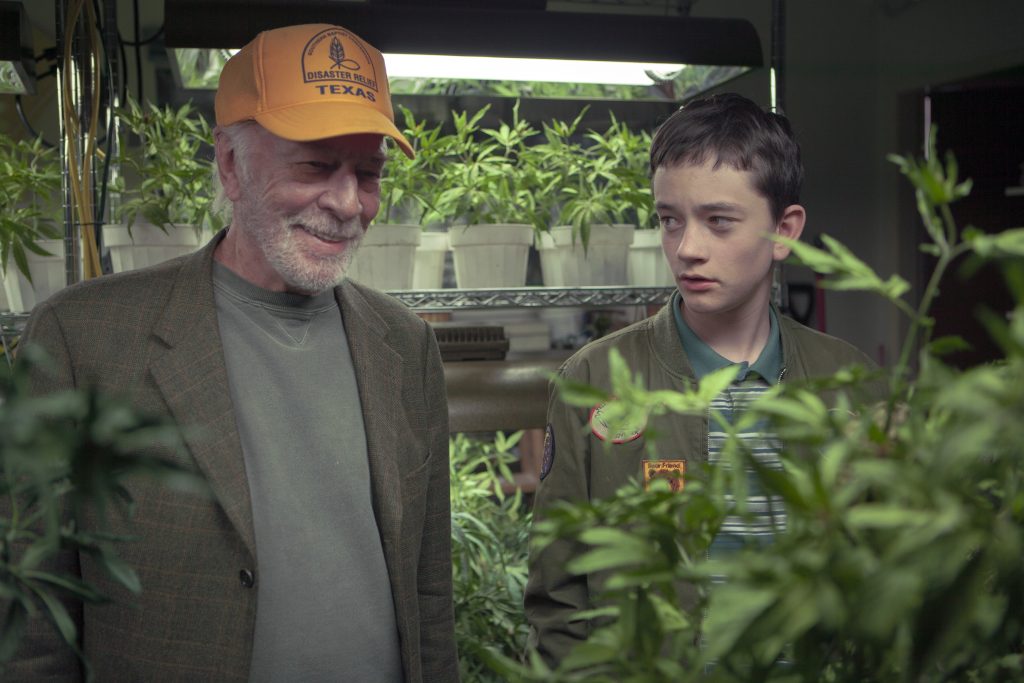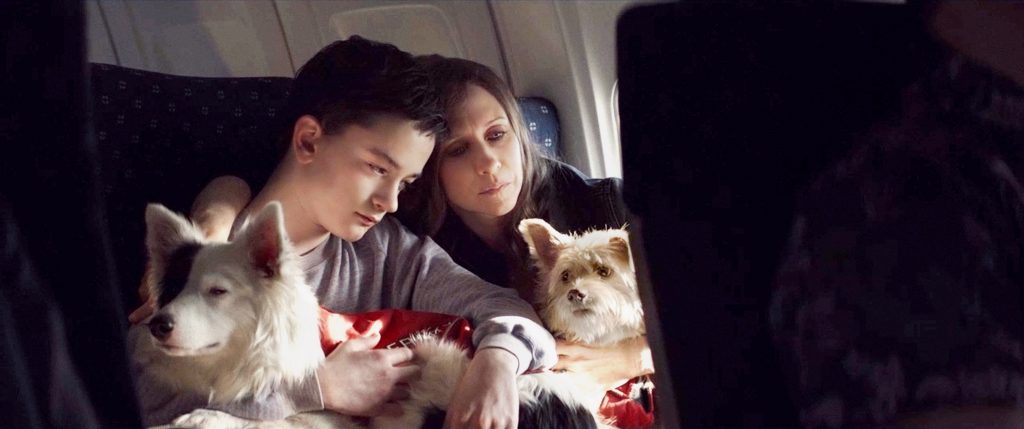January 8, 2022
by Carla Hay

Directed by Alan Taylor
Culture Representation: Taking place from 1967 to 1972, in New Jersey and New York, the mobster drama film “The Many Saints of Newark” features a predominantly white cast of characters (with some African Americans) representing the working-class and middle-class involved in mafia activities.
Culture Clash: Members of the Moltisanti and Soprano families of “The Sopranos” TV series rise through the ranks of the Italian American mafia in New Jersey while having conflicts with each other, as an underage Tony Soprano is groomed to learn the family’s crime business.
Culture Audience: “The Many Saints of Newark” will appeal primarily to fans of “The Sopranos” and predictable mobster movies with good acting.
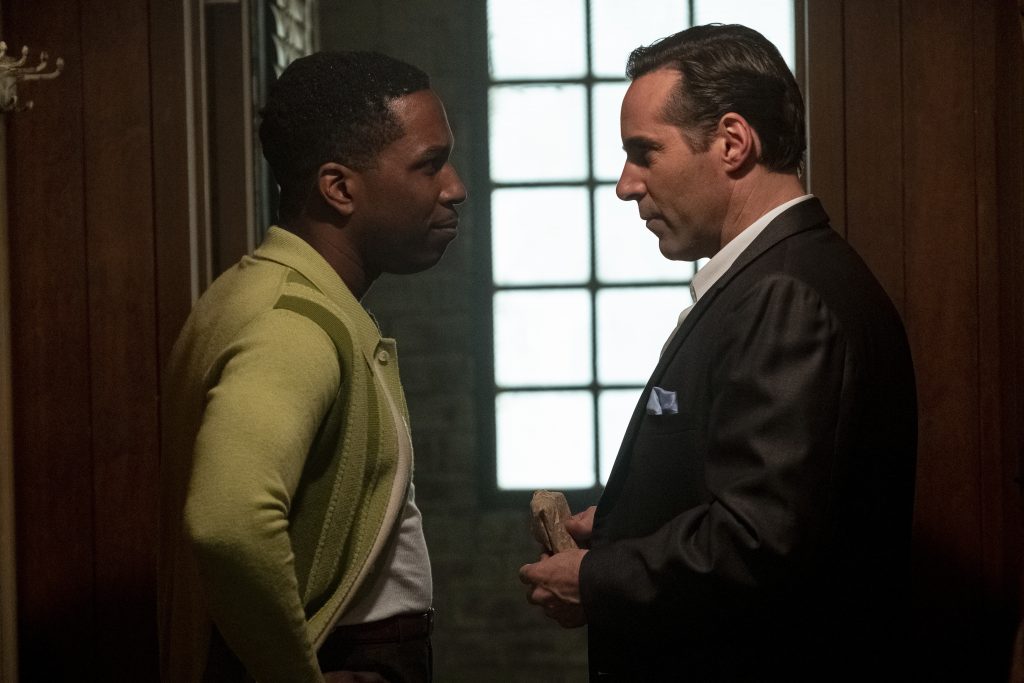
As a movie prequel to “The Sopranos” series, “The Many Saints of Newark” disappoints by not making Tony Soprano the main character. However, the cast members are so talented, they elevate this typical mobster drama. You don’t have to be familiar with “The Sopranos” to understand “The Many Saints of Newark,” although the movie is more enjoyable to watch for anyone who has a basic level of knowledge about “The Sopranos,” which won 21 Primetime Emmy Awards during its 1999 to 2007 run on HBO. At times, “The Many Saints of Newark” looks more like it’s trying to be a Martin Scorsese mafia film than a “Sopranos” prequel.
Directed by Alan Taylor and written by “The Sopranos” showrunner David Chase and Lawrence Konner, “The Many Saints of Newark” opens with a scene of a graveyard that shows the gravestone of Christopher Moltisanti, Tony Soprano’s troubled protégé, whom Tony killed in Season 6 of the series. Christopher (voiced by Michael Imperioli) is briefly a “voice from the dead” narrator to explain to viewers that this story will go back in time (from 1967 to 1972), to show how Christopher’s father Dickie Moltisanti (played by Alessandro Nivola) became a mafia mentor to Tony.
It’s not the ghost of Christopher who really haunts “The Saints of Newark.” It’s the ghost of James Gandolfini, the actor who made Tony Soprano an iconic character in “The Sopranos.” Gandolfini died in 2013, at the age of 51. Any TV show or movie that’s about “The Sopranos” saga has a huge void to fill without Gandolfini playing the role of the adult Tony Soprano. It’s a void that really can’t be filled, but “The Many Saints of Newark” makes an attempt to create another “larger than life” mafia character for “The Sopranos” saga, but it’s extremely difficult for any “Sopranos” character to overshadow Tony and his legacy.
“The Many Saints of Newark” is about Dickie (Tony’s first mentor) more than anyone else. The movie reveals the family tree in bits and pieces for any viewer who doesn’t know the family background. Dickie’s father is Aldo “Hollywood Dick” Moltisanti (played by Ray Liotta), who has an identical twin brother named Salvatore “Sally” Moltisanti (also played by Liotta), who is in prison for murder. Dickie is a cousin of Carmela De Angelis (played by Lauren DiMario), Tony’s high-school sweetheart who would later become his wife. Even though Dickie is not related to the Sopranos by blood, he becomes so close to Tony, Dickie is eventually referred to as Tony’s “uncle.”
Tony’s parents are Giovanni Francis “Johnny Boy” Soprano (played by Jon Bernthal) and Livia Soprano (played by Vera Farmiga), who have very different personalities. Johnny is gregarious and fun-loving, while Livia is uptight and judgmental. During the five years that this movie takes place, Tony is seen when he’s 11 years old (played by William Ludwig) and when he’s 16 years old (played by Michael Gandofini, the real-life son of James Gandolfini).
Tony, his parents and his two younger sisters live in the Ironbound neighborhood of Newark, New Jersey. Tony’s sisters Janice and Barbara are doted on by their parents, while Tony feels negelcted in comparison. (Mattea Conforti portrays Janice as a child, Alexandra Intrator portrays Janice as teenager, and Lexie Foley portrays Barbara as a child.)
A family party celebrating Janice’s confirmation in the Catholic religion shows how much Tony feels like an ignored outsider in his own family. Dickie is one of the people who’s a regular at the Soprano family gatherings because members of the Soprano family and the Moltiscanti family work for the DiMeo crime family that rules this part of New Jersey. It’s at Janice’s confirmation party that Tony sees his father Johnny and Dickie talking about some mafia business. Tony is intrigued.
Tony is intelligent, but his academic grades don’t reflect that intelligence because Tony doesn’t really like school. It’s the first sign that he’s not comfortable with authority figures or following rules. Livia is overly critical of Tony and thinks he’s not as smart as Tony actually is. At one point, Tony’s teacher Mrs. Jarecki (played by Talia Balsam) tells Livia that Tony is intelligent and has leadership potential. Livia’s reaction is to say that there’s a difference between being smart and being a smart aleck.
Johnny’s older brother Corrado John “Junior” Soprano Jr. (played by Corey Stoll) is more stoic and serious-minded than Johnny. (Dominic Chianese played Junior in “The Sopranos” TV series.) Johnny and Junior eventually have a rivalry over who will rise the highest in the DiMeo crime family. But when this story takes place, Dickie’s father Hollywood Dick has more seniority than Junior and Johnny.
Much of the family drama in “The Saints of Newark” is about the tensions between Dickie and his father. Hollywood Dick abused his first wife (Dickie’s mother), who is now deceased. It’s implied that she was killed by her husband, who got away with the crime. Dickie’s father was abusive to him too when Dickie was a child. Dickie’s childhood is not shown in flashbacks, but it’s described in conversations. As an adult, Dickie has a love/hate relationship with his father.
In 1967, Hollywood Dick arrives back in Newark from a trip to Italy and has someone with him: a much-younger Italian woman named Giuseppina (played by Michela De Rossi), whom Hollywood Dick impulsively married in Italy. Giuseppina, who is described as a beauty queen, barely knows English and is young enough to be her new husband’s daughter. She’s really a trophy wife who doesn’t hide the fact that she married Hollywood Dick so that she could live in America as the wife of a man who can take care of her financial needs.
Hollywood Dick introduces Giuseppina to Dickie for the first time after she has already become Hollywood Dick’s wife. Dickie and his wife Joanna (played by Gabriella Piazza) eventually become parents to Christopher, their first child. Even though Dickie and Giuseppina are married to other people, it doesn’t take long for Giuseppina and Dickie to start looking at each other lustfully. Their feelings are also accelerated when Dickie finds out that his father is abusing Giuseppina. Dickie feels very protective of her, and he wants to help Giuseppina in her dream to own her own hair salon.
Meanwhile, Dickie is in regular contact with some of the African Americans who are part of the criminal underground in Newark. Harold McBrayer (played by Leslie Odom Jr.) collects bets for the mafia. In an early scene in the movie, Harold is shown beating up Leon Overall (played by Mason Bleu), the leader of an African American gang called the Saints, because Leon is suspected of stealing from Harold.
“The Many Saints of Newark” makes some attempt to be more racially diverse than “The Sopranos” by having a subplot about how Harold’s relationship with Dickie changes over time. The movie also has scenes depicting racial tensions, such as the Newark race riots and what happens when Harold’s relationship with Dickie is tested for another reason. But because the African American people in this movie are supporting characters, issues of racism are not at the forefront of this story.
And where is Tony Soprano during all of Dickie’s family drama? The movie trailers for “The Many Saints of Newark” make it look like the teenage Tony Soprano will be in nearly all of the film. He’s not. The teenage Tony Soprano doesn’t appear until 51 minutes into this two-hour movie.
Tony is a rebellious teen who needs a father figure more than ever when his father Johnny is arrested and sent to prison for assault with a deadly weapon. The arrest takes place in front of Tony and Janice. During Johnny’s incarceration, Dickie becomes even more of an influence on Tony.
Viewers who are looking for more insignt into Tony and Carmela’s teenage relationship won’t really get it in “The Many Saints of Newark.” There’s a scene where Tony and a few friends show off to Carmela by stealing an ice cream truck and giving away free ice cream to people in the neighborhood during this theft. At this point, Tony and Carmela aren’t officially a couple. He’s showing a romantic interest in her, but she’s not really all that impressed with him.
“The Many Saints of Newark” gives more background information about Tony’s rocky relationship with his mother Livia. There’s a minor subplot about Livia being in therapy (it’s implied that she might have bipolar disorder), she’s prescribed Elavil, and Tony wants some of the Elavil too. The only point to this subplot is that it’s a foreshadowing nod to a well-known “Sopranos” story arc about an adult Tony being in psychiatric therapy. Tony’s sessions with his therapist Dr. Melfi (played by Lorraine Bracco) were among the most-praised aspects of the TV series.
In addition to Tony and his sisters, “The Many Saints of Newark” has the younger versions of some other “Sopranos” characters, but they aren’t given much to do in this movie. John Magaro portrays a younger Silvio Dante, who was played by Steven Van Zandt in the TV series. Billy Magnussen depicts Paulie Walnuts, a role played by Tony Serico in the TV series. Samson Moeakiola is in the role of Pussy Bonpensiero, who was played by Vincent Pastore in the TV series.
However much “The Many Saints of Newark” might have been marketed as a Tony Soprano origin story, this movie is really a Dickie Moltisanti story, with Tony as a supporting character. The movie’s tagline is “Who Made Tony Soprano?,” but it still seems like a “bait and switch” marketing ploy. Throughout much of the movie, viewers might be asking instead, “Where is Tony Soprano?”
Fortunately, the performances by all of the movie’s cast members (especially Nivolo, Liotta, Odom and Farmiga) maintain a level of interest, along with the suspenseful aspects of the story. However, people who’ve seen enough American mafia movies will find a lot of familiar tropes in “The Many Saints of Newark.” Taylor doesn’t do anything spectacular with the movie’s direction. Chase and Konner approached the screenplay as if delving into Tony Soprano’s underage youth ultimately wouldn’t work as the central focus of a movie that showcases very adult crimes.
“The Saints of Newark” is not a bad movie, but it’s not a great one either, considering the high bar set by “The Sopranos.” The movie’s technical aspects, including the cinematography and production design, are perfectly adequate, but everything about “The Many Saints of Newark” looks like a made-for-TV movie, not a big event movie that was made for a theatrical release. As long as viewers know in advance that Tony Soprano is not the central character of “The Many Saints of Newark,” they have a better chance of enjoying this watchable but not essential entry in “The Sopranos” saga.
Warner Bros. Pictures released “The Many Saints of Newark” in U.S. cinemas and on HBO Max on October 1, 2021.




